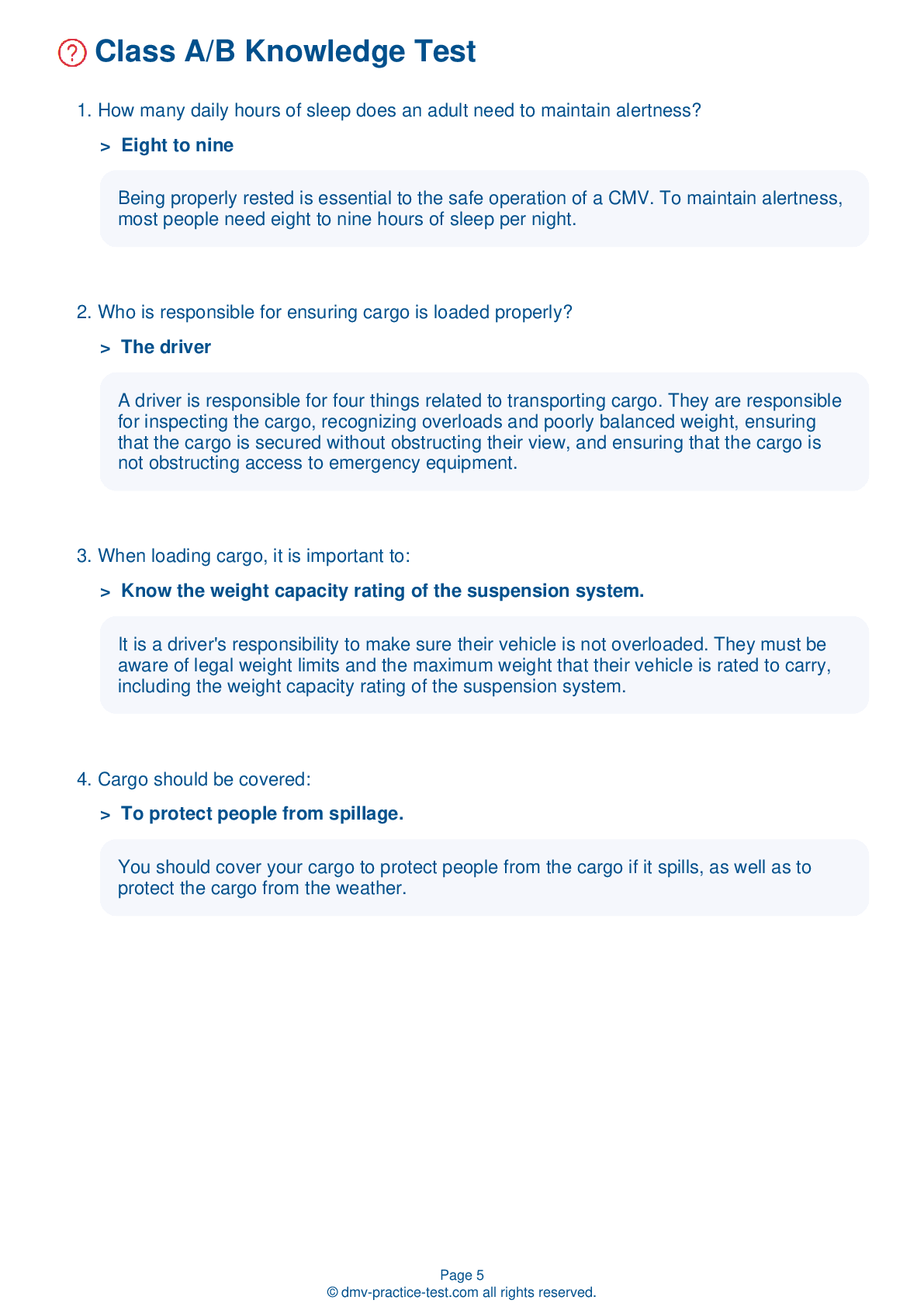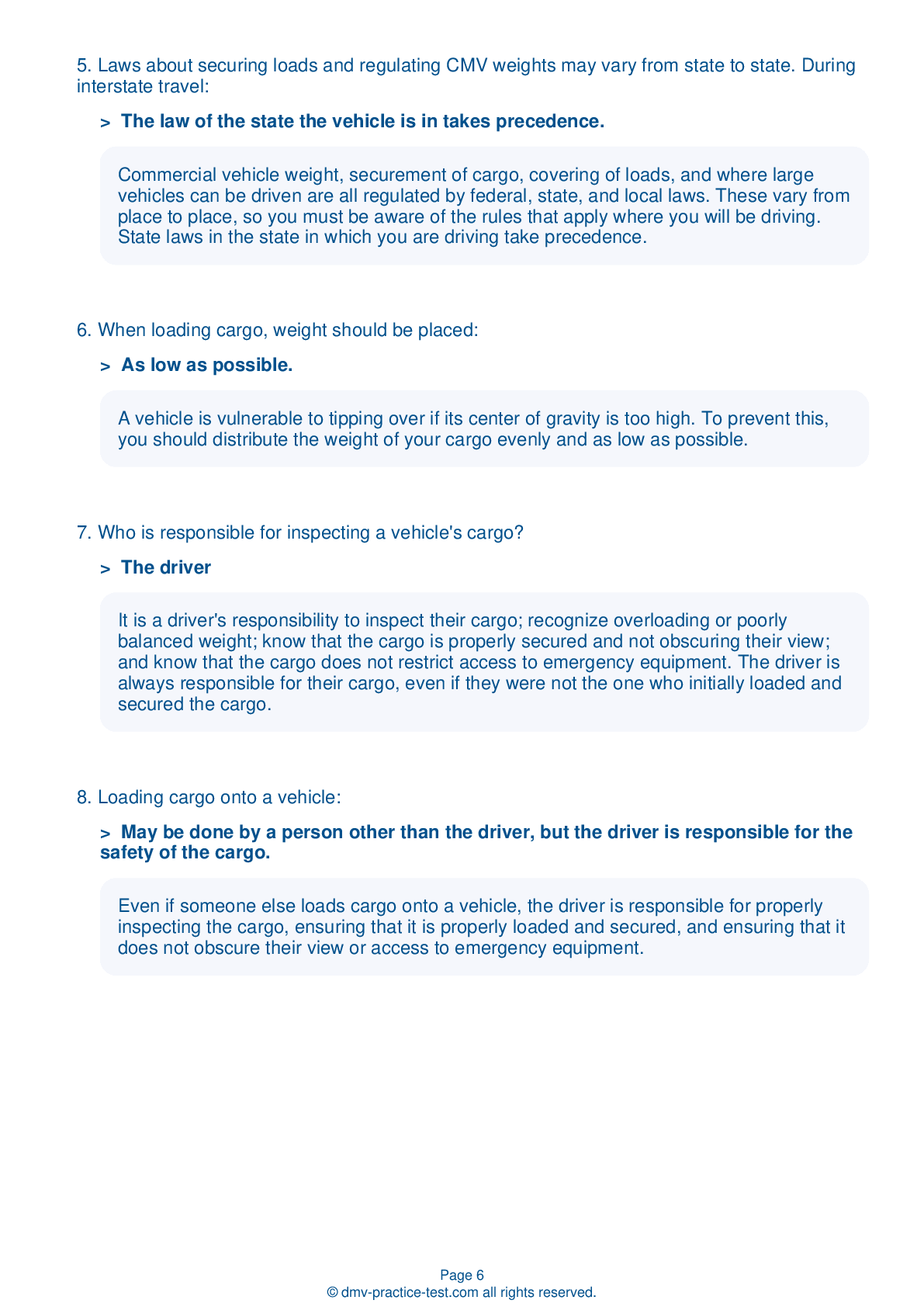HazMat #1
Hazmat Test | Connecticut 2025 #1 Page 5 of 5
On our website, we provide FREE practice - CDL hazmat test online! The official exam test consists of several obligatory parts, with all of them checking your knowledge of different blocks of road rules. If you need to obtain a CT CDL hazmat endorsement in 2025, practice as much as possible. Free sample tests published on our website will help you check and improve your knowledge and boost your grades. Please bear in mind that Connecticut requirements for issuing a hazmat endorsement for CDL may vary from those established in other states.
30
24
20
25 . If corrosive materials leak in the trailer, the trailer should be:
Cleaned with bleach.
Parts of a vehicle that have been exposed to a corrosive material must be thoroughly washed with water.
26 . Who is responsible for identifying the hazard class of a hazardous material?
Everyone
The shipper of hazardous materials is responsible for using the hazardous materials regulations to determine the product's identification number, proper shipping name, hazard class, and packing group. They are also responsible for determining the correct packaging, labels, markings, and placards to use.
27 . How often do hazardous materials employees need to be trained?
Employees who work with hazardous materials must be trained and tested at least once every three years.
28 . You can find the identification numbers assigned to hazardous chemicals:
The U.S. Department of Transportation (DOT)'s Emergency Response Guide provides information about hazardous materials, indexed by proper shipping names and hazardous materials identification numbers.
29 . On a shipping paper, the identification number, shipping name, and hazard class should:
On hazardous materials shipping papers, the identification number, shipping name, and hazard class must not be abbreviated, unless specifically authorized in the hazardous materials regulations.
30 . Unless a package is clearly unsafe, what does the driver need to accept a package of hazardous materials?
A court order
Unless a package is clearly unsafe or does not comply with the Hazardous Materials Regulations, you may accept the shipper's certification that it was properly packaged.
2025 Connecticut | Frequently Asked Questions
To acquire a CDL Hazmat endorsement in Connecticut, you must first have a Commercial Driver's License (CDL). Then, pass the Hazardous Materials Endorsement Knowledge Test. You also need to complete a federal security threat assessment (TSA background check), including fingerprinting. Visit your local DMV to start the process and get additional information.
To obtain a CDL Hazmat license, you must have a valid Commercial Driver's License (CDL). You are required to pass the Hazardous Materials Endorsement Knowledge Test. A federal security threat assessment, including fingerprinting and a background check by the Transportation Security Administration (TSA), must also be completed. You should have a clean driving record as well.
When applying for a CDL Hazmat endorsement, you'll need to provide proof of U.S. citizenship or lawful permanent residency, such as a valid U.S. passport or birth certificate. You'll also need your current Commercial Driver's License (CDL), social security card, and proof of Connecticut residency. A completed application form (H-170) is also required, available from the Connecticut DMV.
Yes, there is a dedicated written test for the CDL Hazmat endorsement. This test covers the necessary knowledge about the transportation of hazardous materials. It includes questions about loading and unloading hazardous materials, bulk packaging, and emergency response procedures. Passing this test is a prerequisite for obtaining the Hazmat endorsement on your CDL.
The CDL Hazmat endorsement written test in Connecticut covers a variety of subjects including identifying different types of hazardous materials, understanding shipping papers, placarding rules, containment rules, emergency response procedures, and safety protocols. It also tests knowledge on loading and unloading hazardous materials and the risks associated with each type of material.
Yes, there are extra charges associated with acquiring a CDL Hazmat endorsement. These include the application fee, fingerprinting fee, and the federal security threat assessment fee. The total cost can be over $100. However, the exact amount can vary and it's best to check with the Connecticut Department of Motor Vehicles for the most current fees.
Yes, a background check and security clearance are mandatory for the CDL Hazmat endorsement. The Transportation Security Administration (TSA) conducts a security threat assessment that includes fingerprinting and a review of criminal, immigration, and terrorism records. This is to ensure the safety and security of hazardous material transportation.
Yes, specialized training is required for the CDL Hazmat endorsement in Connecticut. Applicants must pass a written test that covers hazardous materials regulations and safety procedures. In addition to passing the test, they must also undergo a federal background check and fingerprinting. These requirements ensure that drivers are adequately prepared to handle hazardous materials safely.
No, you cannot transport hazardous materials without a valid CDL Hazmat endorsement in Connecticut. It is a federal requirement and it's illegal to do so without the proper endorsement. Violations can result in substantial fines, imprisonment, and disqualification from holding a commercial driver's license.
Yes, you can add the CDL Hazmat endorsement to your current CDL license. You'll need to pass the Hazmat knowledge test, undergo a TSA background check, and pay the necessary fees. It's not a new license, but an addition to your existing CDL.



